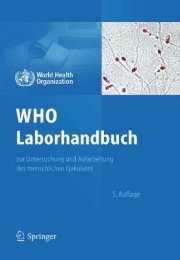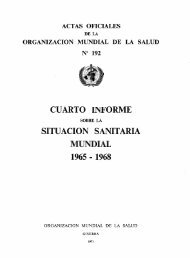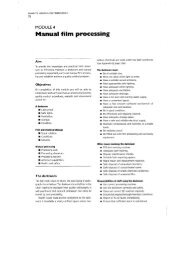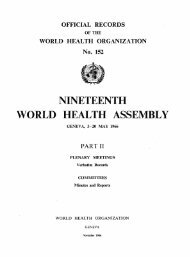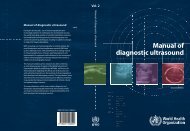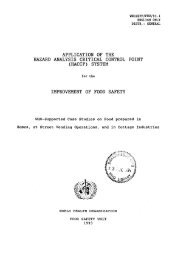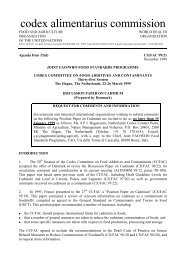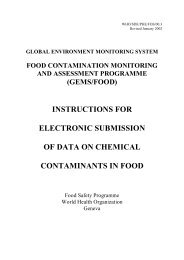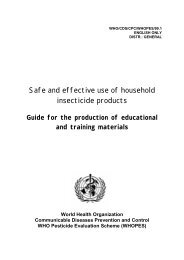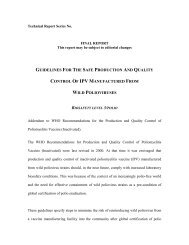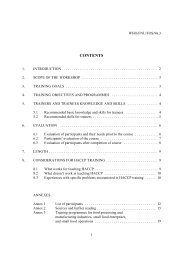WHO Drug Information Vol. 20, No. 4, 2006 - World Health ...
WHO Drug Information Vol. 20, No. 4, 2006 - World Health ...
WHO Drug Information Vol. 20, No. 4, 2006 - World Health ...
You also want an ePaper? Increase the reach of your titles
YUMPU automatically turns print PDFs into web optimized ePapers that Google loves.
<strong>WHO</strong> <strong>Drug</strong> <strong>Information</strong> <strong>Vol</strong> <strong>20</strong>, <strong>No</strong>. 4, <strong>20</strong>06<br />
than isoniazid or moxifloxacin in clearing<br />
the infection during the continuation<br />
phase, it was not better than that of a<br />
rifampicin+isoniazid combination. However,<br />
when a 6-month treatment regimen<br />
containing PA- 824 in combination with<br />
rifampicin, isoniazid and pyrazinamide<br />
was tested in mice, the PA-824 containing<br />
regimens were superior to the standard<br />
first line regimen in terms of more rapid<br />
reductions of the bacterial burden during<br />
treatment and lower rates of relapse after<br />
treatment. PA-824 entered phase I clinical<br />
trials in June <strong>20</strong>05.<br />
Nitroimidazole OPC-67683<br />
(Otsuka Pharmaceuticals, Japan)<br />
Little information about this compound is<br />
publicly available. It belongs to a subclass<br />
of mycolic acid inhibitors. In vitro, OPC-<br />
67683 showed high activity against drugsensitive<br />
as well drug-resistant strains.<br />
<strong>No</strong> cross-resistance with any of the<br />
current first-line drugs was observed.<br />
Moreover, OPC-67683 showed strong<br />
intracellular activity against H37Rv strain<br />
of M. tuberculosis residing within human<br />
macrophages and type II pneumocytes.<br />
When tested in mouse models for chronic<br />
tuberculosis, OPC-67683 showed a 6–7<br />
fold higher activity compared to first line<br />
drugs isoniazid and rifampicin. <strong>No</strong> antagonist<br />
activity could be observed when<br />
OPC-67683 was used in combination with<br />
currently used anti-TB drugs in vivo.<br />
Pyrrole LL- 3858 (Lupin Limited, India)<br />
Very limited information on the development<br />
of pyrroles as antimycobacterial<br />
agents is currently available. Pyrrole<br />
derivatives were found to be active<br />
against standard and drug-sensitive M.<br />
tuberculosis strains in vitro. Pyrrole<br />
derivative LL-3858 showed higher bactericidal<br />
activity than isoniazid when administered<br />
as monotherapy to infected mice.<br />
Pyrrole LL3858 is currently in Phase I<br />
clinical trials.<br />
Medicines for Tuberculosis<br />
Pleuromutilins (GlaxoSmithKline–<br />
TB Alliance Partnership)<br />
The pleuromutilins represent a novel<br />
class of antibiotics derived from a natural<br />
product. They interfere with protein<br />
synthesis by binding to the 23S rRNA.<br />
Despite the novelty of this class of compounds,<br />
recent studies have shown that<br />
cross-resistance might occur among<br />
pleuromutilins and oxazolidinones.<br />
Pleuromutilins have been shown to inhibit<br />
the growth of M. tuberculosis in vitro. The<br />
goal of this project is the identification of a<br />
pleuromutilin derivative that is active<br />
against MDR-TB and allows shortening of<br />
the treatment schedule.<br />
Dipiperidine SQ-609 (Sequella Inc.)<br />
Dipiperidine SQ-609 is a novel compound<br />
structurally unrelated to existing anti-TB<br />
drugs. It kills M. tuberculosis by interfering<br />
with cell wall biosynthesis (precise<br />
mechanism unknown). Antimicrobial<br />
activity has been demonstrated in vivo in<br />
mouse models.<br />
ATP Synthase Inhibitor FAS<strong>20</strong>013<br />
(FASgene)<br />
FAS<strong>20</strong>013 is a novel compound belonging<br />
to the class of ß-sulphonylcarboxamides.<br />
The compound is very effective<br />
in killing MDR-TB organisms that are<br />
resistant to multiple drugs currently in<br />
use. A series of recent laboratory experiments<br />
indicates the superior effect of<br />
FAS<strong>20</strong>013 compared to current drugs in<br />
terms of its ability to “sterilize” TB lesions<br />
and kill latent TB. Therapeutic evaluation<br />
of FAS<strong>20</strong>013 has repeatedly shown its<br />
effectiveness in mice, and it appears to<br />
have no serious side effects.<br />
Translocase I Inhibitor (Sequella Inc.)<br />
Translocase inhibitors specifically inhibit<br />
mycobacterial translocase I, an enzyme<br />
required for bacterial cell wall synthesis.<br />
Preclinical evaluation of the compounds<br />
is planned.<br />
243



